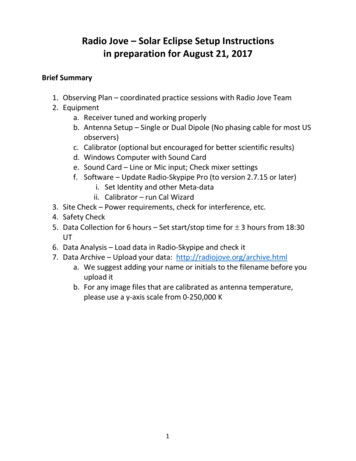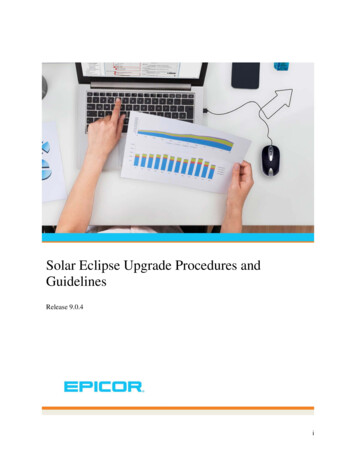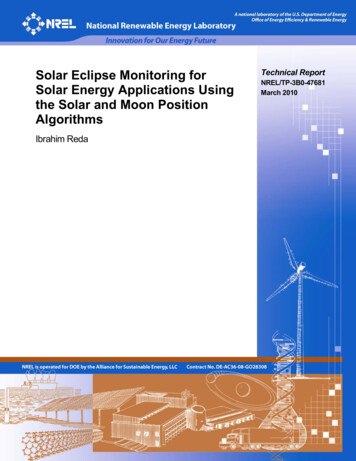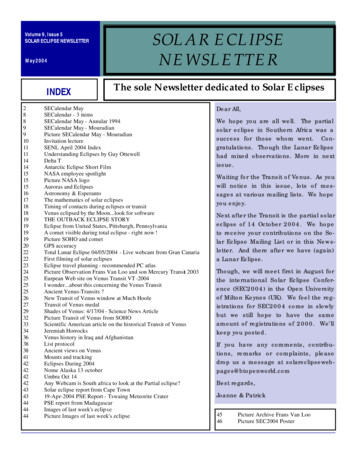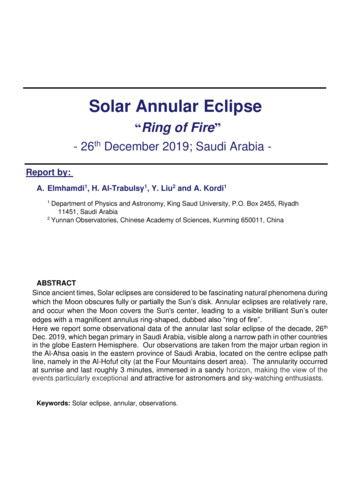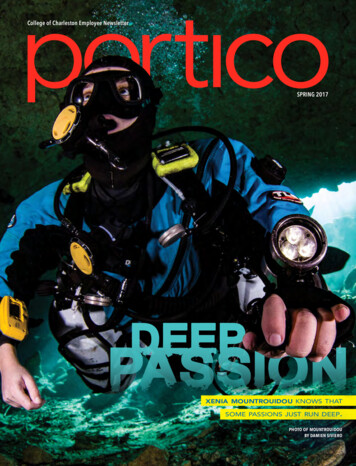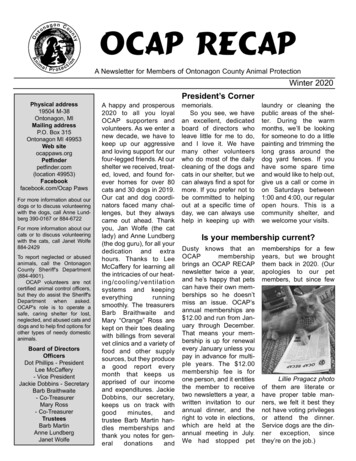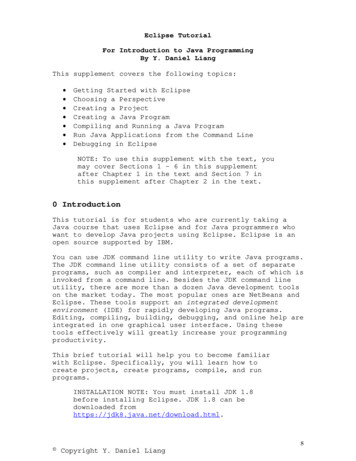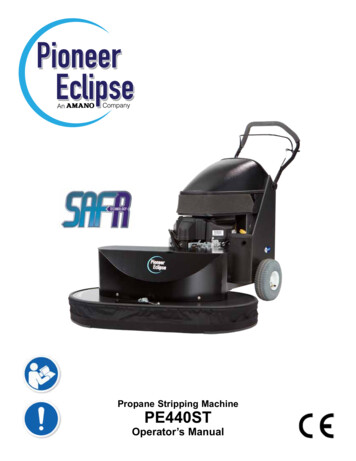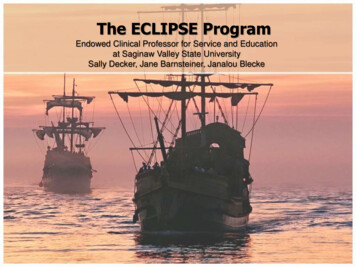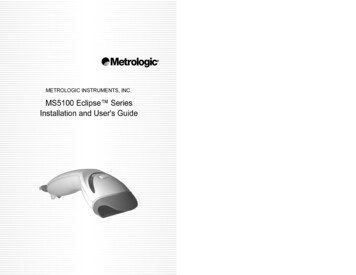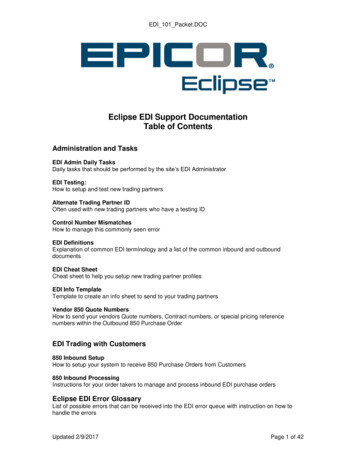
Transcription
Volume 8, Issue 9SOLAR ECLIPSE NEWSLETTERSOLAR ECLIPSENEWSLETTERSeptember 2003INDEX 1 Picture C90 and Sony in Gib2 SECalendar for September10 SEC2004 one year to go11 SENL August on line11 Picture Jay Anderson'sweather forecast for TSE 200612 Smallest Eclipse12 Occult Software is free13 Image Stabilized Binoculars13 Saros questions14 Gerald Hawkins Obituary14 Transit of Venus expedition14 Earliest known European solarobservatory15 ER and its solar eclipse15 World Atlas Solar EclipsePaths: 1000 BCE to 1000 CE16 August 11, 1999 Eclipse Elixir16 Travelling Birds Movie16 New Web pages16 A bizarre solar eclipse andSamurai Jack connection17 Solar Eclipse Animations:2001-205018 Photo18 Picture Mars occultation19 HST Image of The SUN19 Picture HST Image of the Sun19 Lunar eclipse on stamps20 Eclipses on Mars22 Antarctica eclipse on TV ?22 History of Antarctic eclipses23 More ships to Antarctica ?23 Antarctic flights23 QANTAS/CROYDONECLIPSE FLIGHT - SeatingAvailability24 ONEO Island (again) [8 April2005]31 Eclipse weather for 2005 and200631 11 Picture Jay Anderson'sweather forecast for H200532 Picture Empire and the Sunbook PangThe sole Newsletter dedicated to Solar EclipsesDear all,The Newsletter for September 2003 is ready as you noticed. The lay out isslightly changed. Eli Maor gave us the advise to avoid as much as possible duplication so the SENL files will be smaller to download. And that is what we did.The front page for an intro and the index and the back page for info aboutSEML subscription. We also made some page layouts bigger. I hope you arefine with this change. If you have suggestions and remarks, send them to us.As you noticed, the SEML traffic is still quite. It means that the next solareclipses are not of that interest and that most topics have been discussed before. If you have contributions please send them to the mailing list of sendthem in for SENL. We had a small off SEML-track about small eclipses. Thereare some interesting messages about the transit of Venus and of course thecoming total solar eclipse of 23 November 2003 in the Antarctic. Jay Anderson,our world famous eclipse weather predictor, released his WebPages.Below a souvenir of the Transit of Mercury Jo, Laura and I observed from Gibraltar. The equipment Jo used for eclipse and transit chasing is shown: C90 andSony 25x.Cheers, Joanne and Patrick
Volume 8, Issue 9SOLAR ECLIPSE NEWSLETTERPage 2SECalendarSeptember 2003Dear All,Please find herewith the solar eclipse calendar (SECalendar) for September. Ifhave any additional information, queries or remarks, please drop us a mail.youFor the whole Solar Eclipse Calendar, see our Solar Eclipse WebPages mSeptember 01, 1859 In 1859, the first solar flare ever to be recorded by humankind. An intense aurora followed the next day. Twoindependent observers, Richard C. Carrington and R. Hodson (UK), described their experiences in volume twenty of the MonthlyNotices of the Royal Astronomical Society. They are the first to observe a flare on the Sun and they both note that a magnetic stormin progress on earth intensifies soon afterwards, but they refrain from connecting the two events.September 02, 2817 Next total solar eclipse in Amsterdam at sun altitude of 14 degrees. Annular eclipses in Amsterdam will be onOctober 2, 2350, March 26, 2639 and May 23, 2878 (the same century as the total solar eclipse).September 03, 0118 ". . . about this time while he was pursuing his studies in Greece, such an omen was observable in the heavens.A crown resembling Iris surrounded the disc of the Sun and darkened its rays." Refers to solar eclipse of 3 September AD 118, orpossibly AD 96. From: Philostratus, Greek (died between AD 224 and 229). Quoted in UK Solar Eclipses from Year 1 by SheridanWilliams.September 03, 1885 Bettina 250: Minor planet discovered 1885 September 3 by Jojann Palisa at Vienna. Named for Baroness Bettina von Rothschild of the Austrian plutocratic family. In Observator, Vol 8 p 63 (1885) the following info was published: "HerrPalisa, being desirous to raise funds for his intended expedition to observe the Total Solar Eclipse of August 29, 1886 will sell theright naming the minor planet N 244 for 50 ".(Ref. VK)September 03, 1998 SOHO recharged his batteries after months of inactivity. (Ref DD 09/99)September 03, 2081 Next large partial solar eclipse in the Netherlands. It is not that large as the one of 1999. Magnitude in Utrechtis 0.902 and 0.939 in Maastricht.September 03, 2081 Next Total Solar Eclipse in France, Germany, etc. Next Total Solar Eclipses in Europe: August 12, 2026 totalin North of Spain shortly after sunset. The year after, August 2, 2027 total in extreme South of Spain and September 12, 2053 totalin extreme South of Spain, September 3, 2081 total in France, South in Germany, Switzerland, Austria, etc., September 23, 2090total in northern France and the southwestern Belgium at sunset.September 04, 0501 The sun was red and dim; within it there was a single black spot. Ref BAA 6/00September 05, 1923 Minor planet (1005) Arago Discovered 1923 September 5 by S. I. Belyavskij at Simeis. Named in honor ofFrançois Arago (1786-1853), since 1843 director of the Paris Observatory, life-secretary of the Academy of Sciences, politician andauthor of the four volume Astronomie Populaire (1854-1857). (H 96) Arago is also honored by craters on Mars and the Moon. Dictionary of Minor Planet Names - ISBN 3-540-14814-0 - Copyright 1999 by Springer-Verlag Berlin HeidelbergSeptember 05, 1984 Landing of STS-41D Discovery: 6 astronauts, of whom 1 paid passenger. 3 satellites launched. Big solarpanel folded open and shots made with IMAX-camera. 1rst flight for Discovery, 12 for all shuttles together (Ref DD 9/99)September 06, 1892 Birth of E. V. Appleton, British physicist. Studied relation between solar and earth atmosphere. Got Nobelprice in 1947 for physics. (ref. DD 9/98)(Continued on page 3)
Volume 8, Issue 9SOLAR ECLIPSE NEWSLETTERPage 3SECalendarSeptember 07, -0246 (247 BC) "[D]iary for year 65 (SE), king Antiochus . . . [month V]. The 28th, 74 deg after sunrise, solareclipse (at) 5 months' distance; when I watched I did not see it." Refers to a solar eclipse of 7 September 247 BC, predicted to takeplace in Babylon, but which was actually far north of Babylon. Babylonian tablet in the British Museum. Quoted in HistoricalEclipses and Earth's Rotation, by F Richard Stephenson, Cambridge University Press, 1997, page 122.September 07, 1820 Partial eclipse in England but annular over the Isles of Shetland. The trial of Queen Caroline was going on inthe House of Lords, and the House suspended its sitting for a short time for the sake of the eclipse. (ref. Chambers, The Story ofEclipses, 1899)September 07, 1858 Neither at Olmos nor Piura, did any enceinte woman leave her room during the eclipse, whilst some from curiosity, but more through fear, were in the streets, yet not daring to look upon the sun, lest malady befall them. The somber green lightgave them the appearance of corpses, and they apprehended that a plague might be visited upon them. Afterwards, the muleteers toldus that their animals stopped eating, and huddled together in evident alarm." Lieut. J M Gillis An Account of the Total Eclipse ofthe Sun on September 7, 1858, as Observed Near Olmos, Peru in Smithsonian Contributions to Knowledge, vol. 11, April 1859,Smithsonian Institution.September 07, 1956 Minor Planet (2165) Young 1956 RJ. Discovered 1956 September 7 at the Goethe Link Observatory at Brooklyn, Indiana. Named in memory of Charles Augustus Young (1834-1908), known affectionately as "Twinkle" Young by the Princeton students. He accepted the professorship of astronomy at Princeton in 1877, the year that his most famous student, Henry NorrisRussell {see planet (1762)}, was born. Earlier he was a professor at Dartmouth, as his father and grandfather had been. He discovered the green line ( lambda 5304) in the solar corona in 1869, and the following year he was the first both to observe the "flashspectrum" and to photograph a prominence. In 1876 he made the first use of the grating spectroscope in astronomy for the determination of the Sun's rotation period. The last of his three successful textbooks, Manual of astronomy, was updated by Russell, Dugan{see planet (2772)} and Stewart in 1926. (M 8798) Name proposed by F. K. Edmondson. Dictionary of Minor Planet Names ISBN 3-540-14814-0 - Copyright 1999 by Springer-Verlag Berlin HeidelbergSeptember 07, 1962 (2624) Samitchell 1962 RE. Discovered 1962 September 7 at the Goethe Link Observatory at Brooklyn, Indiana. Named in memory of Samuel Alfred Mitchell (1874-1960), a faculty member of Columbia University from 1899 to 1913 andthen director of the Leander McCormick Observatory until 1945, known for his work on solar eclipses and stellar parallaxes. Hismeasurements of the flash spectrum at the eclipses in 1900, 1901 and 1905 referred to nearly 3,000 lines. His book Eclipses of theSun went through five editions. His photographic parallax work with the McCormick refractor resulted in the publication of 2,001parallaxes by 1950. Subsequent work by van de Kamp {see planet (1965)} and Vyssotsky {see planet (1600)}, encouraged and supported by Mitchell, yielded absolute proper motions of 29,000 stars between magnitudes 8 and 12. (M 10844) Name proposed by F.K. Edmondson. Dictionary of Minor Planet Names - ISBN 3-540-14814-0 - Copyright 1999 by Springer-Verlag Berlin HeidelbergSeptember 09, 1934 Minor Planet (1670) Minnaert 1934 RZ. Discovered 1934 September 9 by H. van Gent at Johannesburg.Named in honor of the late Prof. Marcel G. J. Minnaert {1893-1970}, who was Director of the Utrecht Observatory from 1937 until1963. He made major contributions to solar research and prepared (with Mulders and Houtgast) the Photometric Atlas of the SolarSpectrum. He was an extraordinarily effective lecturer and writer in the popularization of astronomy. (M 3185) Minnaert is als ohonored by a lunar crater. Obituaries published in Astron. Nachr., Vol. 292, p. 192 (1970); Orion, 28. Jahrg., p. 195 (1970); Hemelen Dampkring, Vol. 68, p. 289-292 (1970); l'Astronomie, Vol. 84, p. 525 (1970); Observatory, Vol. 90, p. 272 (1970); Sky Telesc.,Vol. 40, p. 344 (1970); Nature, Vol. 229, p. 214 (1971); Astrophys. Space Sci., Vol. 10, p. 183-185 (1971); Solar Phys., Vol. 17, p.3-5 (1971); Astron. Tidsskr., Vol. 3, p. 199-200 (1970); Icarus, Vol. 15, p. 147-148 (1971); Q.J.R. Astron. Soc., Vol. 12, p. 338-341(1971); Irish Astron. J., Vol. 11, p. 161 (1973). Dictionary of Minor Planet Names - ISBN 3-540-14814-0 - Copyright 1999 bySpringer-Verlag Berlin HeidelbergSeptember 09, 1991 Minor planet (7127) Stifter 1991 RD3. Discovered 1991 Septemb er 9 by F. Börngen and L. D. Schmadel atTautenburg. Named for the most famous Austrian narrator Adalbert Stifter (1805-1868). After formative years spent in the Bohemian Forest, he studied near the Benedictine Abbey in Kremsmünster, later living in Vienna and Linz {see planets (397) and(1469)}. In his brillant novels and epics (The Timber Forest, Rock Crystal, Indian Summer and Witiko) landscapes were describedin a superb manner. Stifter described the correlation of man and nature in a subtle manner, full of feeling. He dealt with questions of(Continued on page 4)
Volume 8, Issue 9SOLAR ECLIPSE NEWSLETTERPage 4SECalendareducation, love and piety, and he was also engaged in painting and science. He gave full details of the total solar eclipse of 1842July 8 as observed in Vienna. (M 29149) Dictionary of Minor Planet Names - ISBN 3-540-14814-0 - Copyright 1999 bySpringer-Verlag Berlin HeidelbergSeptember 09, 1994 Launch of STS-64 Discovery with 6 astronauts for nearly 11 days. Experiments with Spartan (solar wind andcorona) and atmosphere research with Lite. (ref. DD 9/98)September 10, 1919 Robert B. Leighton, was born on 10 Sep 1919. OK, during the only total eclipse he tried to observe (Hawaii1991), he was clouded out. But, using the 60-ft. solar tower at Mt. Wilson (California) more than 30 years earlier, he had discoveredthe 5-min. and 15-min. oscillations of the Sun, thereby creating the field of helioseismology, which occupies several dozen scientistsaround the world today. (GONG, etc.) (Ref. AL 9/99)September 10, 1923 Hildago 944:Minor planet discovered October 31, 1920 by W. Baade at Bergedorf. German astronomers observed the Total Solar Eclipse 1923 September 10 in Mexico. After the Eclipse they had an audience with the president of Mexicoand asked permission to call this planet after Miguel Hidalgo y Costilla (1753-1811) who proclaimed the Mexican independence in1810. AN 221, 159 (1924). Ref VK 6/97September 10, 1967 Surveyor 5 (US) makes a soft landing on the moon. Made more then 19.000 pictures and landed 25 km fromthe later landing place of Apollo 11. (ref. DD 9/98)September 10, 1978 Minor Planet (2100) Ra -Shalom 1978 RA. Discovered 1978 September 10 by E. F. Helin at Palomar. Namedby the discoverer for the Egyptian sun-god Ra, who symbolizes enlightenment and life, and for Shalom, the traditional Hebrewgreeting meaning peace. This name is chosen to commemorate the Camp David mid-east peace conference, at which time this unusual body was found. May it stand as a symbol for the universal hope for peace. (M 4548) Dictionary of Minor Planet Names ISBN 3-540-14814-0 - Copyright 1999 by Springer-Verlag Berlin HeidelbergSeptember 11, 1972 Minor planet 2238) Steshenko 1972 RQ1. Discovered 1972 September 11 by N. S. Chernykh at Nauchnyj.Named in honor of Nikolaj Vladimirovich Steshenko {1927- }, deputy director of the Crimean Astrophysical Observatory, whosecomprehensive support has contributed to the success of the program for the discovery and observation of minor planets. Wellknown for his work in solar physics, he is in charge of the program of solar observations from space, and he is the author of the design for the Soviet 25-m-diameter mosaic optical telescope. (M 5850) Dictionary of Minor Planet Names - ISBN 3-540-14814-0 Copyright 1999 by Springer-Verlag Berlin HeidelbergSeptember 12, 1838 Birth of Arthur J. G. F. von Auwers, German astronomer. He reviewed the distance of the sun several times,using transits of Venus and a close encounter of a minor planet. Ref DD 9/99.September 12, 1851 Birth of Sir Arthur Schuster (1851-1934). A comet is discovered and photographed by Sir Arthur Schuster(1851-1934), Germany/UK, during an eclipse in Egypt: first time a comet discovered in this way has been photographed. The TotalSolar Eclipse had been observed by Sir Joseph Norman Lockyer (1836-1920), Ranard and Schuster from England, Tacchini fromItaly, Trépied, Thollon and Puiseux from France. Observation from Sohag at the Nile. (Ref. Rc 1999)September 13, 1178 Vigeois, France ., on a clear day, about the 5th hour, the Sun suffered an eclipse,. (Ex Chronico GaufrediVosiensis, Bouquet, 1781, p447) Ref PG 9/99.September 13, 1912 Birth of H. W. Babcock, American astronomer. Studied magnetic fields of the sun. (ref. DD 9/98)September 13, 1955 Minor Planet (3167) Babcock 1955 RS. Discovered 1955 September 13 at the Goethe Link Observatory atBrooklyn, Indiana. Named in memory of Harold D. Babcock (1882-1968) and in honor of his son Horace W. Babcock, astronomersat Mount Wilson Observatory, the latter also serving as director of Palomar Observatory. The elder Babcock's precise laboratorystudies of atomic spectra allowed others to identify the first "forbidden" lines in the laboratory and to discover the rare isotopes ofoxygen. With C. E. St. John and others, he extended Rowland's tables of the solar spectrum into the ultraviolet and infrared. TheBabcocks ruled excellent large gratings, including those used in the coudé spectrographs of the 2.5-m and 5-m telescopes, and theymeasured the distribution of magnetic fields over the solar surface to unprecedented precision. The younger Babcock invented andbuilt many astronomical instruments, including the solar magnetograph, microphotometers and automatic guiders. By combining his
Volume 8, Issue 9SOLAR ECLIPSE NEWSLETTERPage 5SECalendarpolarization analyzer with the spectrograph he discovered magnetic fields in other stars, and he developed important models of sunspots and their magnetism. (M 15089) Name proposed by F. K. Edmondson. Citation prepared by J. Tenn. Obituary published inQ.J.R. Astron. Soc., Vol. 10, p. 68-72 (1969). Harold Babcock is also honored by a lunar crater. Dictionary of Minor Planet Names ISBN 3-540-14814-0 - Copyright 1999 by Springer-Verlag Berlin HeidelbergSeptember 14, 1923 Minor planet (1073) Gellivara Discovered 1923 September 14 by J. Palisa at Vienna. Named for the smalltown Gällivare in Swedish Lapland where in the year 1927 astronomers from several countries observed the total solar eclipse of1927 June 29. (H 101) Named by the Austrian astronomer J. Rheden and endorsed by Anna Palisa. Dictionary of Minor PlanetNames - ISBN 3-540-14814-0 - Copyright 1999 by Springer-Verlag Berlin HeidelbergSeptember 14, 1994 Ulysses (ESA) reached the south pole of the sun (-80,22 degrees). (ref. DD 9/98)September 16, 1950 Minor planet (1613) Smiley 1950 SD. Discovered 1950 September 16 by S. Arend at Uccle. Named in honorof Charles Hugh Smiley {1903-1977}, interested mainly in orbit computations by Leuschner's method, director of the Ladd Observatory and professor at Brown University, Providence, R.I. (M 3931) Smiley not only worked on the field of minor planet dynamics. He led 14 solar eclipse expeditions, in Peru, Canada, Brazil, Thailand, Pakistan, and the U.S.A., and did much work on the studyof the Mayan calendar. Obituaries are published in J.R. Astron. Soc. Canada, Vol. 72, p. 46-47 (1978); Q.J.R. Astron. Soc., Vol. 19,p. 510-511 (1978). Dictionary of Minor Planet Names - ISBN 3-540-14814-0 - Copyright 1999 by Springer-Verlag Berlin HeidelbergSeptember 17, 1354 " In this year on 17 September that novelty appeared. The Sun became dark on a Wednesday at about the thirdhour and it lasted for the space of two hours. Above the Sun and Moon, which were joined together - that is, the Moon was coveringthe Sun - there appeared a very large star with fiery rays like a torch . . . Many people viewed the rays of the sma ll Sun by reflectionin a mirror or in clear water. And the rays of the Sun were so small and so dark, on account of the Moon covering the Sun, that theredid not remain un-obscured as much as 3 fingers of the Sun. . . Everyone appeared deathly pale." Refers to a total solar eclipse inPerugia, Italy, of 17 September 1354. From: Memorie di Perugia dall'anno 1351 al 1438 Quoted in Historical Eclipses and Earth'sRotation, by F Richard Stephenson, Cambridge University Press, 1997, page 421.September 17, 1354 Perugia, Italy In this year on 17 september that novelty appeared. The Sun became dark on a Wednesday atabout the third hour and it lasted for the space of two hours. (Memorie di Perugia dall'anno 1351 al 1438) Ref PG 9/99September 17, 1982 Minor planet (4567) Becvár 1982 SO1. Discovered 1982 September 17 by M. Mahrová at Klet. Named inmemory of the Czech astronomer Antonín Becvár (1901-1965), founder and first director of the Skalnaté Pleso {see planet (2619)}Observatory in Slovakia. Becvár made observations of comets, meteors and the solar photosphere, but he is best known as the authorof Atlas Coeli and the more detailed Atlases Eclipticalis, Borealis and Australis. (M 21956) Becvár is also honored by a lunar crater. Dictionary of Minor Planet Names - ISBN 3-540-14814-0 - Copyright 1999 by Springer-Verlag Berlin HeidelbergSeptember 18, 1783 Death of Leonhard Euler (1707-1783), Swiss mathematician and astronomer. Observed transit of Venus in1769 and determent herewith the distance to the sun being 151.225.000 km. (ref. DD 9/98, Rc 1999)September 18, 1819 Birth of Jean Bernard Leon Foucault (1819-1868), F
SOLAR ECLIPSE NEWSLETTER SOLAR ECLIPSE NEWSLETTER 1 Picture C90 and Sony in Gib 2 SECalendar for September 10 SEC2004 one year to go 11 SENL August on line 11 Picture Jay Anderso n's weather forecast for TSE 2006 12 Smallest Eclipse 12 Occult S
